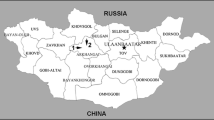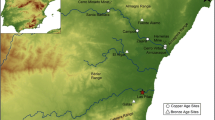Abstract
Lavishly decorated wagons excavated from royal Xiongnu burials are generally regarded as tribute items from China offered to Xiongnu elites, symbolizing important political and economic interactions between the Xiongnu state (209 BC–155 AD) and the Han dynasty (206 BC–220 AD). This theory views such vehicles as having no relation to indigenous Xiongnu craftsmanship. Furthermore, specialized products delivered to the northern nomadic peoples from the Han state are often cited in support of the notion of Xiongnu dependency on foreign states for technological and political development. Expecting to find evidence of China’s traditional iron and bronze technology, we examined a number of key metallic components of these wagons excavated from the royal Xiongnu burial at Golmod 2 in central Mongolia, radiocarbon dated to 109 BC–AD 75. Surprisingly, the iron metallurgy in question was based primarily on the bloomery process while low tin bronze and arsenical copper alloys dominated the pertinent bronze production. These respective technological traditions are typical of Xiongnu manufacture but significantly different from traditional Han metallurgy. We interpret this evidence as suggesting the need for a more balanced evaluation of foreign influence on the rise and development of the Xiongnu state.





Similar content being viewed by others
References
Anthony DW (2007) The horse the wheel and language—how Bronze-Age riders from the Eurasian steppes shaped the modern world. Princeton University Press, Princeton and Oxford
Bagley RW (1987) Shang ritual bronzes in the Arthur M. Sackler collections. The Arthur M. Sackler Foundation, Washington, D.C. and The Arthur M. Sackler Museum, Harvard University, Cambridge, Massachusetts, Distributed by Harvard University Press
Barfield T (2001) The shadow empires: imperial state formation along the Chinese-nomad frontier. In: Alcock S, D’Altroy T, Morrison K, Sinopoli C (eds) Empires: perspectives from archaeology and history. Cambridge University Press, Cambridge, pp 10–41
Barnard N (1961) Bronze casting and bronze alloys in ancient China. Monumenta Serica Monograph 14. The Australian National University and Monumenta Serica, Canberra
Brosseder U (2009) Xiongnu terrace tombs and their interpretation as elite burials. In: Bemmann J, Parzinger H, Pohl E, Tseveendorzh D (eds). Current archaeological research in Mongolia (papers from the first international onference on archaeological research in Mongolia, held in Ulaanbaatar, August 19th–23rd 2007) Bonn Contributions to Asian Archaeology 4, Bonn, pp. 247–280
Chunag A, Gelegdorj E, Park JS (2006) Technical transition observed in cast iron artifacts from Khitan sites at Bulgan Aimag, Mongolia. Studia Archaeol 23.3:128–143 (in Mongolian, with English abstract)
Erdenebaatar D, Iderkhangai T, Galbadrakh B, Minjiddorj E, Orgilbayar S (2011) Excavations of satellite burial 30, tomb 1 complex, Gol Mod 2 necropolis. In: Brosseder U, Miller B (eds). Xiongnu archaeology: multidisciplinary perspectives of the first steppe empire in Inner Asia, Bonn: Rheinische Friedrich-Wilhelms-Universität, pp. 303–314
Erdenebaatar D, Iderkhangai T, Mijiddorj E, Orgilbaiar S, Batbold, N, Galbadrakh B, Maratkhaan, A (2015) Investigation of Xiongnu elite burials GOL MOD-2 at Balgasyn Tal. Excavation Report, Ulaanbaatar.
Eregzen G (ed) (2011) Treasures of the Xiongnu-culture of Xiongnu, the first nomadic empire in Mongolia (Khunnugiin ov: nuudelchdiin ankhny tor Khunnu gurnii soel). Institute of Archaeology, Ulaanbaatar
Honeychurch W (2013) The nomad as state builder: historical theory and material evidence from Mongolia. J World Prehist 26(4):283–321
Honeychurch W (2014) Alternative complexities: the archaeology of pastoral nomadic states. J Archaeol Res 22:277–326
Khazanov A (1994) Nomads and the outside world. University of Wisconsin Press, Madison
Khazanov A (2001) Nomads in the history of the sedentary world. In: Khazanov A, Wink A (eds) Nomads in the sedentary world. Curzon, London, pp 1–23
Kradin N (2002) Nomadism, evolution, and world-systems: pastoral societies in theories of historical development. J World-Syst Res 8:368–388
Lechtman H (1999) The production of copper-arsenic alloys (arsenic bronze) by Co-smelting: modern experiment, ancient practice. J Field Archaeol 26:497–526
Miller BK (2012) Vehicles of the steppe empire: chariots and carts in Xiongnu tombs. Silk Road 10:29–38
Miller BK, Allard F, Erdenebaatar D, Lee C (2006) A Xiongnu tomb complex at Gol Mod 2 cemetery, Mongolia (2002-05). Mongolian J Anthropol, Archaeol Ethnol 2(2(271)):1–21
Park JS (2012) A preliminary study on the role and implication of plate-type iron artifacts in the ancient iron technology of Korea. J Archaeol Sci 39:1925–1932
Park JS, Eregzen G (2015) A preliminary study on the loss of iron and arsenic in the re-melting of iron-bearing arsenical copper. Archaeometry 57(5):869–878
Park JS, Reichert S (2015) Technological tradition of the Mongol Empire as inferred from bloomery and cast iron objects excavated in Karakorum. J Archaeol Sci 53:49–60
Park JS, Shinde S (2013) Iron technology of the ancient megalithic communities in the Vidarbha region of India. J Archaeol Sci 40(11):3822–3833
Park JS, Chunag A, Gelegdorj E (2008) A technological transition in Mongolia evident in microstructure, chemical composition and radiocarbon age of cast iron artifacts. J Archaeol Sci 35:2465–2470
Park JS, Eregzen G, Yeruul-Erdene C (2010) Technological traditions inferred from iron artefacts of the Xiongnu Empire in Mongolia. J Archaeol Sci 37:2689–2697
Park JS, Honeychurch W, Chunag A (2011) Ancient bronze technology and nomadic communities of the middle Gobi Desert, Mongolia. J Archaeol Sci 38:805–817
Park JS, Erdenebaatar D, Eregzen G (2015) Evolution of Mongolian bronze technology with the rise of Xiongnu state. Archaeol Anthropol Sci. doi:10.1007/s12520-015-0304-x
Polosmak NV, Tseveendorj D, Bogdanov ES (2007) Noin-Ula No. 20 Tomb. In: National Museum of Korea (eds). Xiongnu, the first Empire of the Steppes. Archaeological research of its tombs (papers from an international symposium in celebration of the 10th anniversary of MON-SOL Project, Seoul, December 7th 2007) Seoul, pp. 156–176
Polosmak NV, Bogdanov ES, Tseveendorj D, Erdene-Ochir N (2008) The Han chariot from Noin Ula mound 20 (Mongolia). Archaeol Ethnol Anthropol Eurasia 36.4:63–69
Rawson J (1990) Western Zhou ritual bronzes from the Arthur M. Sackler collections, Volume IIA, Ancient Chinese bronzes from the Arthur M. Sackler collections, The Arthur M. Sackler Foundation, Washington, D.C. and The Arthur M. Sackler Museum, Harvard University, Cambridge, Massachusetts, Distributed by Harvard University Press
Rogers JD (2012) Inner Asian states and empires: theories, data, and synthesis. J Archaeol Res 20:205–256
Rostoker W, Bronson B (1990) Pre-industrial iron: its technology and ethnology. In: Archaeomaterials Monograph, vol. 1. University Museum Publications, Philadelphia Pennsylvania
Rudenko S (1970) Frozen tombs of Siberia: the Pazyryk burials of Iron Age horsemen. University of California Press, Berkeley
So J (1995) Eastern Zhou ritual bronzes from the Arthur M. Sackler collections. Volume III, The Arthur M. Sackler Foundation in association with The Arther M. Sackler Gallery, Smithsonian Institution, Distributed by Harry Abrams, Inc
Spengler R, Frachetti M, Doumani P (2014) Late Bronze Age agriculture at Tasbas in the Dzhungar Mountains of eastern Kazakhstan. Quat Int 348:147–157
Svyatko S, Schulting RJ, Mallory J, Murphy EM, Reimer PJ, Khartanovich VI, Chistov YK, Sablin MV (2013) Stable isotope dietary analysis of prehistoric populations from the Minusinsk Basin, southern Siberia, Russia: a new chronological framework for the introduction of millet to the eastern Eurasian steppe. J Archaeol Sci 40:3936–3945
Umehara S (1937) Rakuyo Kinson Kobo Shuei (outstanding specimens from the ancient tombs of Chin-ts’un, Loyang). Kobayashi Shuppan-bu, Kyoto
Wagner DB (1996) Iron and steel in ancient China. E.J. Brill, Leiden, New York, Köln
Wu H-Y (2013) Chariots in early China: origins, cultural interaction, and identity. BAR International Series, Oxford
Yü YS (1967) Trade and expansion in Han China. Berkeley, University of California Press, A Study in the Structure of Sino-Barbarian Economic Relations
Acknowledgements
This work would not have been possible without the kind support from the people of Ulaanbaatar University who showed unusual hospitality to one of the authors (JSP) when he visited Ulaanbaatar with his wife to acquire samples for examination. Dr. William Honeychurch is gratefully acknowledged for his invaluable advice on the theoretical parts of this manuscript. This work was supported by the National Research Foundation of Korea (NRF) grant funded by the Korea government (NRF-2013R1A1A2059128).
Author information
Authors and Affiliations
Corresponding author
Rights and permissions
About this article
Cite this article
Park, JS., Erdenebaatar, D. & Eregzen, G. The implication of the metallurgical traditions associated with Chinese style wagons from the royal Xiongnu tomb at Golmod 2 in Mongolia. Archaeol Anthropol Sci 10, 1535–1546 (2018). https://doi.org/10.1007/s12520-017-0476-7
Received:
Accepted:
Published:
Issue Date:
DOI: https://doi.org/10.1007/s12520-017-0476-7




